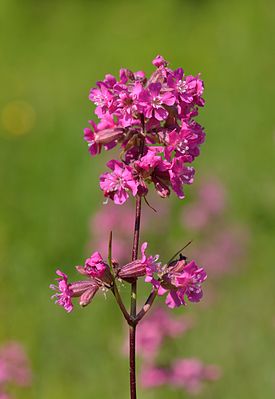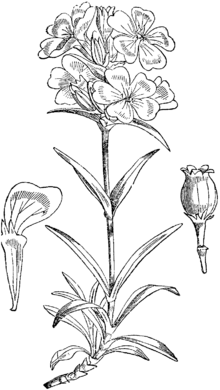Common Pechnelke
| Common Pechnelke | ||||||||||||
|---|---|---|---|---|---|---|---|---|---|---|---|---|

Common Pechnelke ( Silene viscaria ) |
||||||||||||
| Systematics | ||||||||||||
|
||||||||||||
| Scientific name | ||||||||||||
| Silene viscaria | ||||||||||||
| ( L. ) Borkh. |
The Ordinary Pechnelke ( Silene viscaria ) is a plant from the genus of Silene ( Silene ) within the family of Caryophyllaceae (Caryophyllaceae). It is widespread in Europe .
description
Appearance and leaf
The common pitch rose grows as a wintering green, perennial herbaceous plant and reaches stature heights of 30 to 60, rarely up to 90 centimeters. Basal non-blooming leaf rosettes are formed. The stem and the mostly reddish inflorescence are very sticky under the nodes. The against-constantly arranged on the stem leaves are linear lanceolate and hairy something at the bottom and ciliate.
Inflorescence, flower and fruit
The flowering period extends from May to June or July and is therefore mainly at the beginning of early summer. The common Pechnelke is sometimes dioecious separately sexed ( diocesan ). The racemose - panicle inflorescence has the shape of a loose thyrse .
The radial symmetry flowers are five-fold with a double flower envelope . The bald calyx is, depending on the source, 9 to 13 or 10 to 16 millimeters long with transverse nerves. The pink to purple petals are usually 12 to 18 (10 to 20) millimeters long, trimmed or slightly edged. There are two-column crown scales that form a side crown . In hermaphroditic and male flowers, there are two circles with five stamens each on the androgynophore . Five carpels have become an ovary grown, many ovules contains. There are five styluses .
The ripe capsule fruit opens into five teeth.
The number of chromosomes is 2n = 24.
ecology
The common pechnelke is a scleromorphic or mesomorphic chamaephyte or a hemicryptophyte . The name Pechnelke stems from the fact that the stems below the nodes have a dark, sticky coating. These areas are believed to have evolved to protect against phytophagous insects such as aphids, which block the path along the stem. From an ecological point of view, it is about male "plate flowers", the side crown of which serves as a barrier to creep in. It is a typical butterfly flower .
The capsule fruits are desiccant spreaders, wind and animal spreaders. Fruit ripening is from June to July.
Occurrence and endangerment
Silene viscaria is widespread from south-west , across central and north to east and south- east Europe and is also found in the Asian part of Turkey. There are localities from Spain , France , Belgium to Germany , Austria , Switzerland , Italy , United Kingdom , Denmark , Sweden , Norway , Finland , Poland , Belarus , Estonia , Latvia , Lithuania , Moldova , European part of Russia , Ukraine , Czech Republic , Slovakia , Hungary , Slovenia , Serbia , Croatia , Bosnia and Herzegovina , Montenegro , Bulgaria , Romania , Albania , Macedonia , Greece to Turkey .
It is a neophyte in the northeastern US states of Connecticut , Maine, Massachusetts , New Hampshire , New York, Ohio .
The common Pechnelke avoids lime. In Central Europe it thrives best on dry, lean soils with little lime .
In Germany, the common pechers are moderately common in central and northern Franconia , in the Bavarian Forest , in Lower Bavaria , Saxony , in the Harz Mountains , in the Palatinate Forest . It is rare in the rest of central and southern Germany. It is absent in the German Alps and Alpine foothills. It occurs very scattered to rarely in north-eastern Germany, Schleswig-Holstein and Brandenburg . It is absent in north-western Germany and on the Lower Rhine. In the red list of endangered plant species in Germany in 1993 it is considered not endangered. There are different risk levels in the German federal states: in Rhineland-Palatinate and Saxony it is considered "not endangered"; in Baden-Wuerttemberg , Bavaria , Hesse , Saarland , Saxony-Anhalt , Schleswig-Holstein and Thuringia , it is rated 3 = "endangered"; in Brandenburg, Mecklenburg-Western Pomerania and North Rhine-Westphalia , it is rated as level 2 = “highly endangered”; in Berlin and Lower Saxony it is "critically endangered"; in Hamburg it is considered extinct. In Germany it occurs in light bushes and forests, heaths , dry grasslands , open locations or at the edge of the forest in the collinous-montane (subalpine) altitude range . In Central Europe it is a character species of the Teucrio-Polygonatetum odorati from the Geranion sanguinei association, but is also found in other societies, e.g. B. in the Viscario-Festucetum.
It thrives in Austria in dry, acidic oak forests and poor grasslands, meadows and paths in the colline to montane altitude . It occurs frequently or rarely in Austria and is absent in Vorarlberg . In Austria it is endangered in the Pannonian region and in the western Alps.
Taxonomy
It was first published in 1753 under the name ( Basionym ) Lychnis viscaria by Carl von Linné in Species Plantarum , 1, p. 436. The new combination to Silene viscaria (L.) Borkh. was published in 1793 by the German botanist Moritz Balthasar Borkhausen in Rheinisches Magazin for the expansion of natural history 1, p. 520. Further synonyms for Silene viscaria (L.) Borkh. are: Steris viscaria (L.) Raf. , Viscaria viscosa Ash. nom. illeg., Viscaria vulgaris Bernh. The specific epithet viscaria means sticky plant.
use
Some varieties are used as ornamental plants in temperate areas .
The common pitchlub is said to strengthen the defenses of the surrounding plants and help against brown rot, among other things . Pechnelkenextrakt is approved in Germany as a plant tonic. An extract from the common pitchers contains a relatively large number of brassinosteroids , which have been shown to have a positive effect on the growth of other plants.
Individual evidence
- ↑ a b c d e Silene viscaria in the Germplasm Resources Information Network (GRIN), USDA , ARS , National Genetic Resources Program. National Germplasm Resources Laboratory, Beltsville, Maryland.
- ↑ a b c d e f g h i Profile: Viscaria vulgaris (Lychnis viscaria, Steris viscaria) at Botanik im Bild / Flora von Österreich , November 6, 2005.
- ↑ a b c d e f g h i j k l m Lychnis viscaria L., Pechnelke. In: FloraWeb.de.
- ↑ a b Erich Oberdorfer : Plant-sociological excursion flora for Germany and neighboring areas . 8th edition. Verlag Eugen Ulmer, Stuttgart 2001, ISBN 3-8001-3131-5 . Page 360.
- ↑ a b c Ruprecht Düll , Herfried Kutzelnigg : Pocket dictionary of plants in Germany and neighboring countries. The most common Central European species in portrait. 7th, corrected and enlarged edition. Quelle & Meyer, Wiebelsheim 2011, ISBN 978-3-494-01424-1 .
- ↑ a b Michael Hassler, Bernd Schmitt Silene viscaria - data sheet at Plant World of Germany .
- ^ Linnaeus scanned in at biodiversitylibrary.org in 1753 .
- ↑ a b B. Frajman, M. Thollesson, B. Oxelman: Taxonomic revision of Atocion and Viscaria (Sileneae, Caryophyllaceae). In: Botanical Journal of the Linnean Society. 173 (2), 2013, pp. 194-210 .
- ↑ Viscaria vulgaris Röhl. in Plants of the World online (POWO) .
- ^ Research report University of Bonn.
Web links
- Common Pechnelke. In: FloraWeb.de.
- Distribution map for Germany. In: Floraweb .
- Silene viscaria (L.) Borkh. In: Info Flora , the national data and information center for Swiss flora . Retrieved October 8, 2015.
- Distribution in the northern hemisphere .
- Thomas Meyer: Data sheet with identification key and photos at Flora-de: Flora von Deutschland (old name of the website: Flowers in Swabia )
- Data sheet with photos.
- Data sheet with photos.

